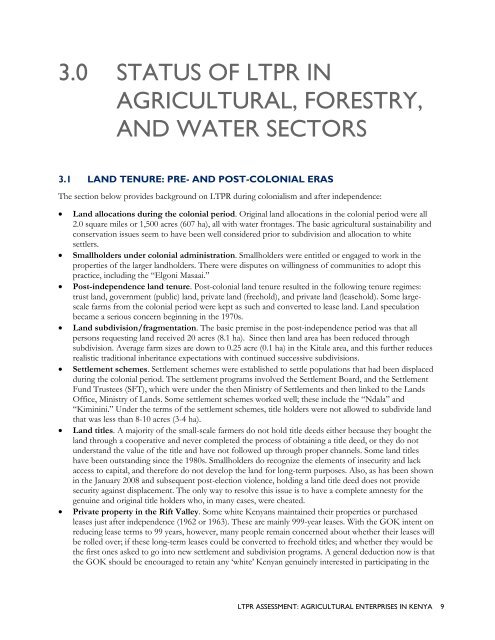Agricultural Enterprise Initiatives of USAID/Kenya - Land Tenure and ...
Agricultural Enterprise Initiatives of USAID/Kenya - Land Tenure and ...
Agricultural Enterprise Initiatives of USAID/Kenya - Land Tenure and ...
Create successful ePaper yourself
Turn your PDF publications into a flip-book with our unique Google optimized e-Paper software.
3.0 STATUS OF LTPR IN<br />
AGRICULTURAL, FORESTRY,<br />
AND WATER SECTORS<br />
3.1 LAND TENURE: PRE- AND POST-COLONIAL ERAS<br />
The section below provides background on LTPR during colonialism <strong>and</strong> after independence:<br />
• <strong>L<strong>and</strong></strong> allocations during the colonial period. Original l<strong>and</strong> allocations in the colonial period were all<br />
2.0 square miles or 1,500 acres (607 ha), all with water frontages. The basic agricultural sustainability <strong>and</strong><br />
conservation issues seem to have been well considered prior to subdivision <strong>and</strong> allocation to white<br />
settlers.<br />
• Smallholders under colonial administration. Smallholders were entitled or engaged to work in the<br />
properties <strong>of</strong> the larger l<strong>and</strong>holders. There were disputes on willingness <strong>of</strong> communities to adopt this<br />
practice, including the “Elgoni Masaai.”<br />
• Post-independence l<strong>and</strong> tenure. Post-colonial l<strong>and</strong> tenure resulted in the following tenure regimes:<br />
trust l<strong>and</strong>, government (public) l<strong>and</strong>, private l<strong>and</strong> (freehold), <strong>and</strong> private l<strong>and</strong> (leasehold). Some largescale<br />
farms from the colonial period were kept as such <strong>and</strong> converted to lease l<strong>and</strong>. <strong>L<strong>and</strong></strong> speculation<br />
became a serious concern beginning in the 1970s.<br />
• <strong>L<strong>and</strong></strong> subdivision/fragmentation. The basic premise in the post-independence period was that all<br />
persons requesting l<strong>and</strong> received 20 acres (8.1 ha). Since then l<strong>and</strong> area has been reduced through<br />
subdivision. Average farm sizes are down to 0.25 acre (0.1 ha) in the Kitale area, <strong>and</strong> this further reduces<br />
realistic traditional inheritance expectations with continued successive subdivisions.<br />
• Settlement schemes. Settlement schemes were established to settle populations that had been displaced<br />
during the colonial period. The settlement programs involved the Settlement Board, <strong>and</strong> the Settlement<br />
Fund Trustees (SFT), which were under the then Ministry <strong>of</strong> Settlements <strong>and</strong> then linked to the <strong>L<strong>and</strong></strong>s<br />
Office, Ministry <strong>of</strong> <strong>L<strong>and</strong></strong>s. Some settlement schemes worked well; these include the “Ndala” <strong>and</strong><br />
“Kiminini.” Under the terms <strong>of</strong> the settlement schemes, title holders were not allowed to subdivide l<strong>and</strong><br />
that was less than 8-10 acres (3-4 ha).<br />
• <strong>L<strong>and</strong></strong> titles. A majority <strong>of</strong> the small-scale farmers do not hold title deeds either because they bought the<br />
l<strong>and</strong> through a cooperative <strong>and</strong> never completed the process <strong>of</strong> obtaining a title deed, or they do not<br />
underst<strong>and</strong> the value <strong>of</strong> the title <strong>and</strong> have not followed up through proper channels. Some l<strong>and</strong> titles<br />
have been outst<strong>and</strong>ing since the 1980s. Smallholders do recognize the elements <strong>of</strong> insecurity <strong>and</strong> lack<br />
access to capital, <strong>and</strong> therefore do not develop the l<strong>and</strong> for long-term purposes. Also, as has been shown<br />
in the January 2008 <strong>and</strong> subsequent post-election violence, holding a l<strong>and</strong> title deed does not provide<br />
security against displacement. The only way to resolve this issue is to have a complete amnesty for the<br />
genuine <strong>and</strong> original title holders who, in many cases, were cheated.<br />
• Private property in the Rift Valley. Some white <strong>Kenya</strong>ns maintained their properties or purchased<br />
leases just after independence (1962 or 1963). These are mainly 999-year leases. With the GOK intent on<br />
reducing lease terms to 99 years, however, many people remain concerned about whether their leases will<br />
be rolled over; if these long-term leases could be converted to freehold titles; <strong>and</strong> whether they would be<br />
the first ones asked to go into new settlement <strong>and</strong> subdivision programs. A general deduction now is that<br />
the GOK should be encouraged to retain any ‘white’ <strong>Kenya</strong>n genuinely interested in participating in the<br />
LTPR ASSESSMENT: AGRICULTURAL ENTERPRISES IN KENYA 9

















